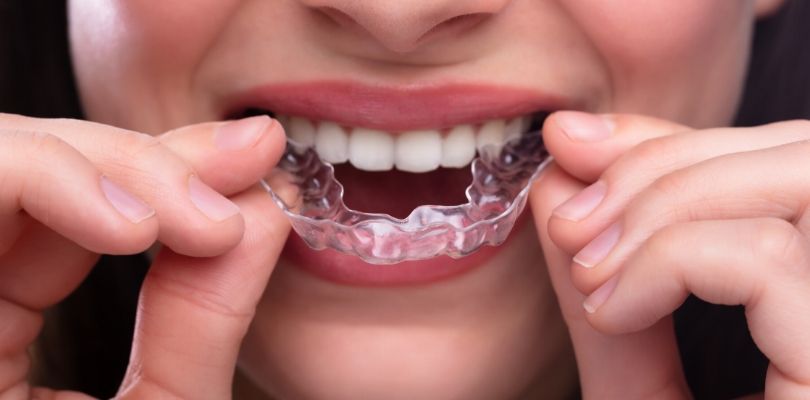What is the Difference Between Braces and Invisalign?
Braces and Invisalign are two different options for people who want to straighten their teeth. Although many people think that tooth straightening is purely cosmetic, it can make a major difference to you overall dental health. There are many options when it comes to straightening your teeth, so be sure to do your research first.
So, should you wear braces or Invisalign? Teeth that are crooked or overcrowded can make it difficult to maintain good oral hygiene, leading to excess plaque and decay. Additionally, problems such as an over or under bite can make eating uncomfortable. As you can see, there is much more to straightening your teeth than just improving your smile.
What Do Braces and Invisalign Do?
Braces and Invisalign both work to straighten teeth. This can help with maintaining oral hygiene, can make eating more comfortable and can improve the overall appearance of your smile.
Braces and Invisalign may be suitable for people with the following problems:
- Crooked teeth
- Protruding teeth
- Overcrowded teeth
- Gaps between the teeth
- Overbite
- Under bite
- Cross bite
- Open bite
Most dentists recommend braces or Invisalign for children between the ages of 12 and 13. At this time, the adult teeth have come through, but the mouth and jaw are still developing.
However, braces or Invisalign can be used by younger children or adults if necessary. Adults wishing to use braces or Invisalign should be aware that treatment can take longer and the results may be limited compared with children and teenagers.
What is the Difference Between Braces and Invisalign?
There are several different types of braces: metal, ceramic and lingual.
As the names suggest, metal braces are made from metal and ceramic braces are made from ceramic. Lingual braces are attached to the backs of the teeth and are more discreet than regular braces.
Invisalign, on the other hand, is made from thin, clear plastic. This is specially melded to fit the shape of each patient’s mouth and is replaced every one to two weeks as the teeth change position.
It’s not just being tired. It’s not something a good night’s sleep with magically repair. It’s chronic fatigue syndrome, and it is debilitating.
One of the major differences between braces and Invisalign is that braces are attached to the teeth 24 hours a day. Invisalign can be removed to eat, brush the teeth and for special occasions. However, to ensure that they can work, the manufacturers recommend keeping Invisalign in for 20 to 22 hours each day.
Some of the advantages of Invisalign over traditional braces is that they are more discreet and can be removed to make eating and brushing the teeth easier. Invisalign should also cause less discomfort than regular braces as they move the teeth more gradually. However, you may still experience some discomfort when wearing a new set of Invisalign for the first time.
Disadvantages of Invisalign include the risk of loss or breakage when they are removed. Invisalign may also be more expensive that regular braces.
Average Cost of Braces and Invisalign
The average cost of braces and Invisalign varies greatly from person to person. It will depend on factors such as overall dental health, how much work needs to be done and your dentist’s location and fees.
The following prices can be used as a rough guide:
- Metal braces - $3000 to $7000
- Ceramic braces - $4000 to $8000
- Lingual braces - $8000 to $10,000
- Invisalign - $4000 to $7400
Both braces and Invisalign will also require you to wear a retainer for up to 12 months after treatment. These can cost between $100 and $500 each.
Your insurance may cover some of the cost of braces or Invisalign. You should also be able to set up a payment plan with your dentist and pay for your treatment in instalments. For example, the Invisalign website offers payment plans between $50 and $200 per month.
You can also use flexible spending accounts (FSA) or health savings accounts (HSA) to pay for braces or Invisalign.
Another way to save money on braces or Invisalign is to look for a local dental college. They may offer supervised treatment from students at reduced rates.
Who is Eligible for Braces or Invisalign?
People may choose braces or Invisalign for the following reasons:
- Crooked teeth
- Protruding teeth
- Gaps between the teeth
- Overcrowding
- Bite problems
- General straightening
Adults with Medicaid or children who get government help with insurance may be eligible for assistance if their treatment is necessary for medical reasons. It will not cover purely cosmetic treatment.
Where to Get Braces or Invisalign
Braces and Invisalign are available from qualified dentists. The Invisalign website has a function where you can type in your ZIP code and find an Invisalign doctor in your area. You will need to visit your dentist for regular check-ups, so choose one in a location that is convenient for you.
You also have the option to use a company called Smile Direct Club. They offer a remote service for people who do not live close to a suitable dentist and their fees can be much lower than average. However, you will not benefit from regular consultations and this might affect the quality of the results.
Before deciding where to get your braces or Invisalign fitted, be sure to do your research first. Look for a dentist with positive online reviews or ask for recommendations from friends and family.
When you go for your first consultation, take a list of questions you would like to ask and ensure that you are happy with the answers. You might want to ask:
- How long will the treatment will last?
- How much will it cost?
- Whether they have had success treating issues like yours in the past
Braces or Invisalign are a big investment, so you want to be sure that you get the best treatment possible. Do not be afraid to shop around to find a dentist who you trust.







